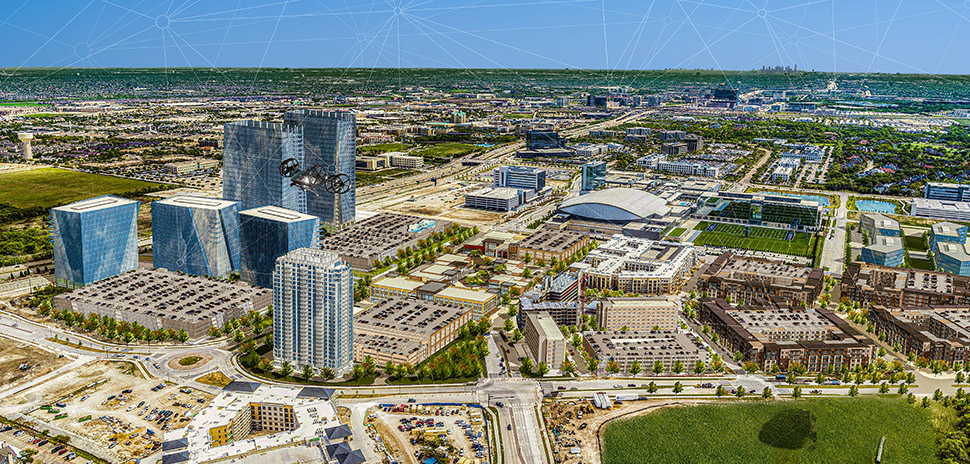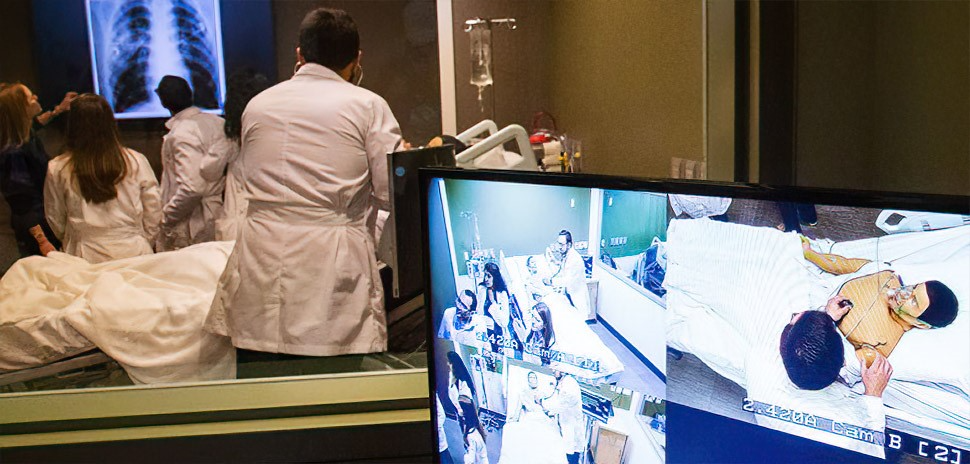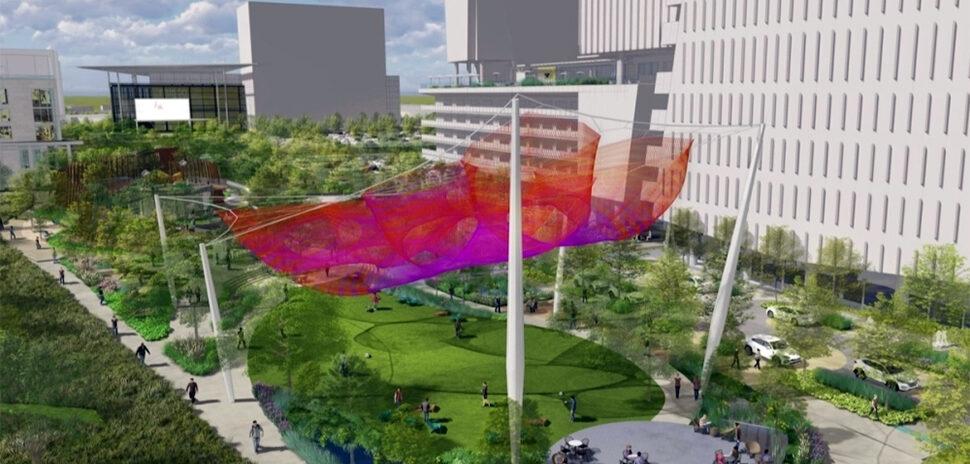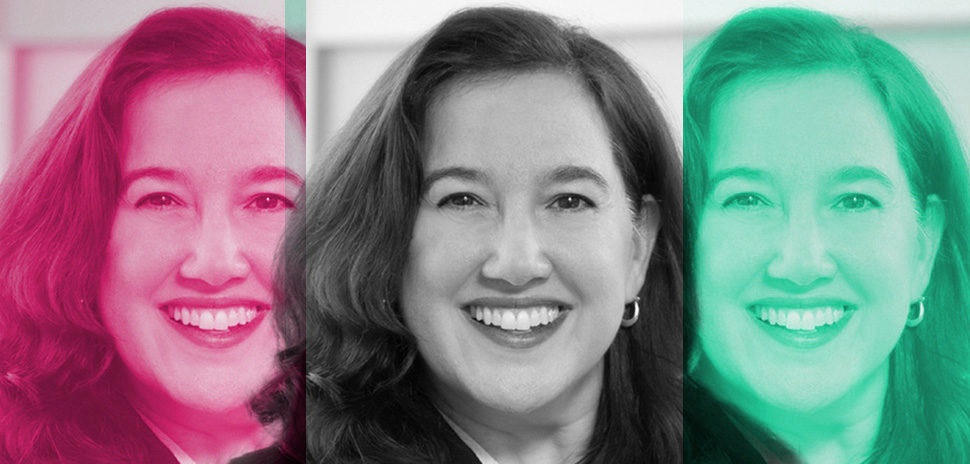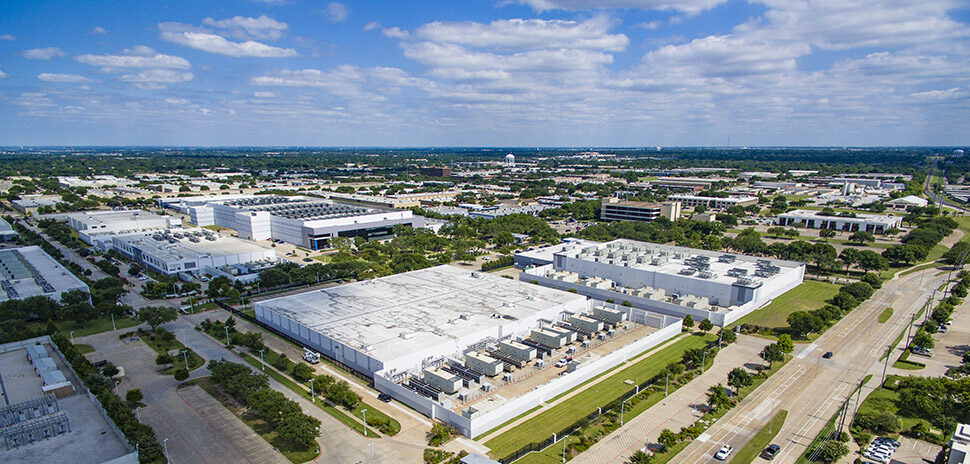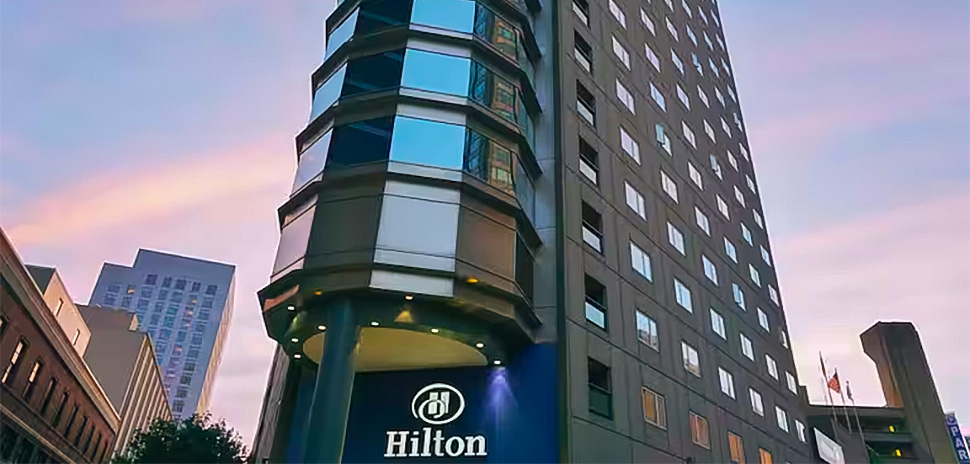Long before tollways, office parks, upscale neighborhoods, high-volume retailers, and major league sports complexes, a large open field in south Frisco produced one thing. High quality hay.
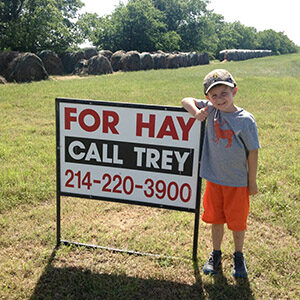
This sign and a few bales of hay are all that used to occupy the land where Frisco Station is being built.
Owned by the Rudman Partnership since 1962, the hay field was edged by trees and dotted with ponds that also made it a prime bird-hunting spot. Frisco Mayor Jeff Cheney recalls seeing a sign as he drove along Lebanon Road in the early 2000s: “For Hay Call Trey.”
Today, the hay sign is gone, but a few bales remain tucked in open spaces between buildings rising up from the prairie. The acreage just west of the Dallas North Tollway now is Frisco Station, a burgeoning mixed-use development that received a kick start from its famous neighbor, The Star.
When the Dallas Cowboys selected Frisco for the Dallas Cowboys World Headquarters and broke ground on The Star development in 2014, the adjacent land quickly became prime real estate. Since the 242-acre Frisco Station site wraps around The Star on the north and west sides, the location quickly became a sought-after location for development.
“When The Star was announced, it really transformed the vision for that area,” Cheney says. “What we originally thought would be low-rise offices shifted gears to really make it an 18-hour district with offices, retail, restaurants, and urban living.”
Rudman Partnership General Manager Trey Sibley no longer was known in Frisco so much for hay but for his management of the family land business that owns more than 6,000 acres in Texas and 17,000 nationwide.
At one time, the Rudman Partnership owned 700 acres on either side of what became the Dallas North Tollway, stretching all the way eastward to Preston Road. Sibley worked with city and regional officials when the Tollway extended north to Highway 380, discussing exits and future connecting roads, a stretch completed in 2007.
About six years later, Sibley learned that Frisco city officials were courting the Cowboys for the city-owned 91 acres adjacent to Rudman’s land.
“When they were successful, we knew this was going to be a central area for development, and it was time for us to start developing,” he says.
Real Estate Dream team
Even before the Cowboys announced their Frisco plans in August 2013, Sibley had suitors wanting to develop the land. He worked for a year in 2011-12 with city officials and others trying to land Nebraska Furniture Mart. He says he believes the group came close before The Colony won the mega furniture store that opened in 2015.
Sibley believes the Cowboys headquarters more than made up for the disappointment over the loss of the retail giant because of all the possibilities The Star opened up.
The Star includes the Cowboys’ offices, the Ford Center (a state-of-the-art practice facility which also hosts Frisco ISD high school football and soccer, along with other sporting events), shops, restaurants, the Omni Hotel, and Baylor Scott & White Sports Therapy and Research Center.
The Rudman property wrapped around The Star, and Sibley and city officials envisioned an upscale mixed-use development focused on the cutting edge of technology and wellness.
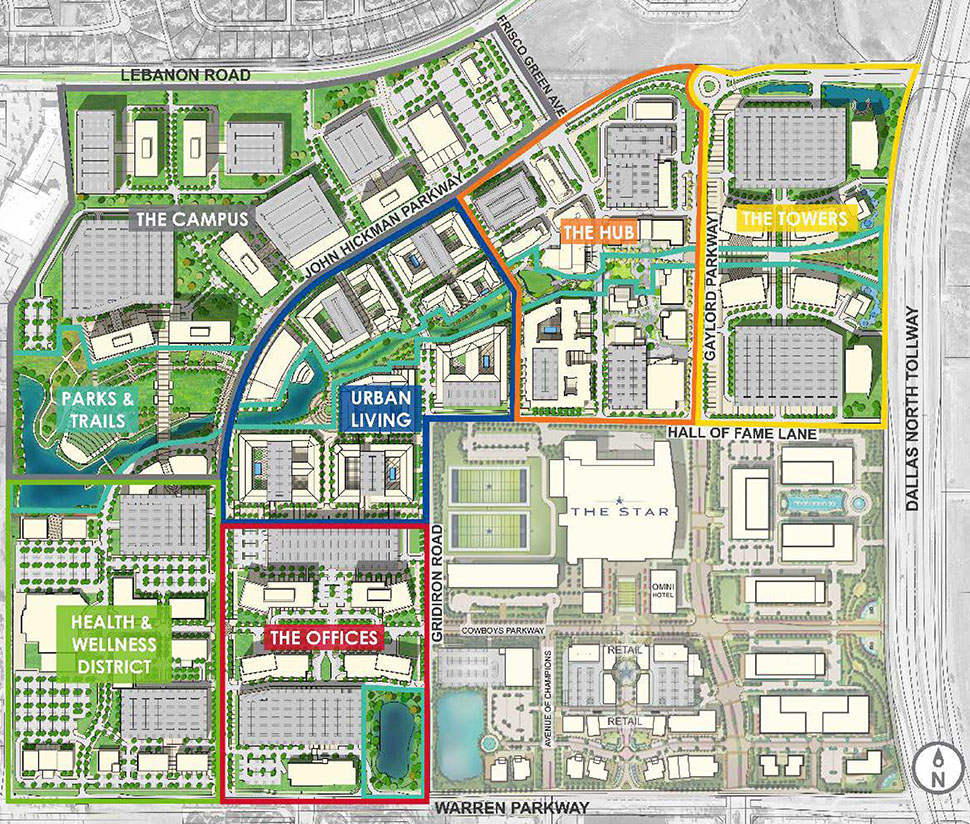
Map: Frisco Station
Frisco Station is designed around three pillars: smart, creative, and healthy, with land set aside for working, living, and playing.
The plan includes 5 million square feet of Class A office space with 15,000 employees on site; 2,400 units of urban living multifamily housing; four hotels; 30 acres of parks and trails; 500,000 square feet for medical, fitness, and spa facilities; and The Hub, which will feature dining, shopping, and entertainment options.
Hillwood came in as a partner in 2014 to oversee the master plan and to develop the retail and urban living portions of the property while VanTrust Real Estate joined the team to develop commercial office space.
Hillwood, owned by Ross Perot Jr., has dozens of developments in North Texas, from mammoth AllianceTexas and Circle T to Victory Park. VanTrust Real Estate, started by the Van Tuyl family who once operated the nation’s largest privately owned auto dealership, has developed office space in the McKinney Corporate Center and the Craig Ranch mixed-use development. The company has other office, industrial, retail, and multifamily developments nationwide, with many of the sites in the Kansas City area.
“Being able to say that the sponsorship of Frisco Station involves the Rudman, Perot, and Van Tuyl families is important,” Sibley says. “We have a very high quality standard we expect in our projects.”
With Rudman Partnership’s “slow, disciplined approach” to the market, Sibley says he was comfortable letting the property remain a hay field for 50 years to wait for just the right opportunities. Involving Hillwood and VanTrust meant the development would continue to focus on the long game.
Sibley calls the partnership “a dream team” in terms of capital and planning compared to the difficulties nearby Wade Park experienced when the original developer struggled to pay contractors and suppliers. Wade Park broke ground in 2014 and initially had Whole Foods, iPic Theaters, and Hotel ZaZa lined up before construction stalled in that project’s early phases.
“It’s not just money you’re after,” Sibley says. “This is our backyard, and we don’t want anything negative tied to our name in our backyard.”
Robert Folzenlogen, senior vice president with Hillwood, says, “We came in due to our experience in larger long-term master-planned development.”
Hillwood team members helped create the vision from scratch, focusing on multiple uses and forward-thinking technology and mobility, Folzenlogen says.
Chris McCluskey, vice president of development for VanTrust, says the opportunity to partner with Hillwood and Rudman made the project more attractive because of their access to capital and long-term approach to development. VanTrust officials also wanted a presence in Frisco.
“Frisco is the hottest market in North Texas and the fifth fastest-growing city in the U.S.,” McCluskey says.
Construction crews broke ground on the $1.8 billion Frisco Station in 2015. The Offices One, a 230,000-square-foot seven-story complex, was the first building completed in December 2017.
At the end of 2019, Frisco Station had The Offices One at 98 percent leased, similar sized The Offices Two nearly completed and 35 percent leased, the Station House urban living apartments open and 98 percent of its 301 units leased, the 25-story SkyHouse at Frisco Station just open with more than 50 of 332 units leased, and a Residence Inn and AC Hotel open.
For 2020, Folzenlogen says he expects completion of a Canopy Hotel by Hilton, construction on the first part of The Hub’s restaurant, retail, and entertainment center to begin in the summer, continued construction on another urban living complex, and the beginning of construction on a third office building.
The start of construction on The Offices Three was announced in late January with completion set for late 2021.
A different approach to technology
When the planning team started looking at what would make Frisco Station successful over the long haul, they kept coming back to the importance of connectivity and mobility. Why? Because today’s employers and employees want easy access to technology and transportation on demand.
Russell Laughlin, executive vice president of Hillwood, says, “We are in a human capital fight. You have to think about how you help companies recruit and retain talented people.”
The office buildings at Frisco Station feature amenities such as on-site fitness centers, indoor and outdoor gathering places, dedicated conference centers, “grab and go” food and drink vending areas, and more.
VanTrust’s McCluskey says, “We know the amenities in the offices are important to our tenants and their talent acquisition and retention strategies. In the past, the name of the game was about cost of the space, and we would tour CEOs and CFOs. Now, it’s all about talent, and the final tour for any space will usually be the CEO and Head of HR.”
For conducting business in the 21st century, access to technology is increasing in importance and volume.
The Offices One is one of seven buildings in Dallas-Fort Worth to receive WiredScore’s Wired Certified Platinum rating. Similar to LEED certification in building practices, Wired Certified Platinum indicates the structure was designed with best available and future connectivity in mind.
During construction, contractors placed fiber optic cable in the ground and in buildings and left dedicated spaces for future improvements.
“We’re thinking about the infrastructure differently to future-proof these projects. It’s all about data,” Folzenlogen says.
To meet the high data requirements of businesses and residents, Frisco Station officials are partnering with AT&T to provide 5G Evolution technology throughout the development.
Folzenlogen says, “We want to provide the most robust digital platform available.”
Eventually, 5G technology is expected to be an exponential change. According to AT&T, 5G Evolution initially will be twice as fast as the current standard, with indications from other industry sources of future speeds 100 times as fast. It also allows for many more devices connecting and using data in a limited area.
Because 5G operates at a micro wavelength instead of the macro wavelength of previous cell phone technology, it will require small cell stations located every few hundred feet in urban areas, according to tech news site Digital Trends. Mini base stations can be mounted on top of streetlights or on the sides of buildings.
At Frisco Station, the first three small cell stations mounted on poles were scheduled for installation before the end of January, with 15 to 20 total planned throughout the development, Folzenlogen says.
Cheney says that 5G is “really going to start rolling” in 2020.
A robust digital infrastructure will continue to attract businesses to Frisco Station.
“Planning their whole campus around that gives them a real advantage,” Cheney says.
Improvements in technology also make possible cutting-edge mobility options such as driverless cars and buses, smart traffic lights, and, eventually on-demand air taxis (see sidebar).
“Everyone believes that smart vehicles would need to be 5G enabled. It allows you to get to the next generation of A.I.,” Laughlin says.
From July 2018 to March 2019, autonomous vehicles from drive.ai operated at Frisco Station, The Star, and the adjacent Hall Office Park through a pilot program.
Frisco Station also is the site of the first urban air taxi “vertiport” in Texas, a testing ground for Uber Elevate.
From easy mobility and high-speed data everywhere to upscale amenities and a wellness focus for those who work and live at Frisco Station, the former hay field is designed to appeal to the modern workforce.
“Our job is to make sure to provide the lifestyle and amenities that employees want so they want to stay,” Sibley says.
KEY PLAYERS
Master planner/architect: Callison RTKL
For the first three office buildings at Frisco Station:
Developer: VanTrust Real Estate
Architect: HKS
Construction: Manhattan Construction
General Contractor: JE Dunn
Other key players
Landscape Design: Studio Outside
Engineer: Kimley-Horn
Architects: BOKA Powell, JHP Urban design
Leasing: cushman & Wakefield
ECONOMIC INCENTIVES
Before the developer can receive any incentive payments, they must first deliver the following:
- 250,000 SF of retail, entertainment, hotel, restaurant space
- 400,000 SF of class A office space
- Dedication of all public rights-of-way at no cost
- Payment of all taxes due on property and development
- Incentives which are reimbursements after performance metrics have been met are:
- ½ of City Sales Tax generated within the Frisco Station Development and actually collected by the City
- ½ of City Ad Valorem Tax generated within the Frisco Station Development and actually collected by the City
- ½ of CDC Sales Tax generated within the Frisco Station Development and actually collected by the City
- ½ of EDC Sales Tax generated within the Frisco Station Development and actually collected by the City
All of the above stops on 12-31-2041—OR—upon hitting the caps.
*EDC – Economic Development Corporation, *CDC – Community Development Corporation
READ THE REST OF THE STORY:
Frisco Station: Hub of Transportation
This story originally appeared in the Dallas-Fort Worth Real Estate Review.
Read the digital edition of Dallas Innovates’ sister publication, the Real Estate Review, on Issuu.
Sign up for the digital alert here.
![]()
Get on the list.
Dallas Innovates, every day.
Sign up to keep your eye on what’s new and next in Dallas-Fort Worth, every day.










